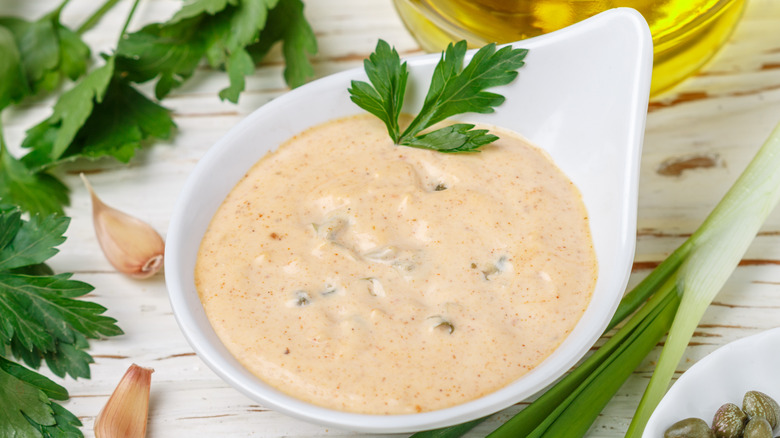How Remoulade Sauce Became A New Orleans Classic
New Orleans is known for Mardi Gras, voodoo, and most importantly, French-inspired Creole and Cajun cuisine, with classic dishes such as gumbo, jambalaya, and po' boy sandwiches. Some meals aren't complete without a sauce, though, and that's where remoulade comes in. This quintessential New Orleans sauce has roots in France, of course, but was given a flavorful spin when it arrived in Louisiana along with the French settlers in the early 1700s. It was the perfect ingredient to jazz up New Orleans cooking, as remoulade accompanied seafood dishes in France, and Cajun and Creole cuisine also has an abundance of seafood.
Remoulade originated in a northern region of France called Picardy around the 1600s. Traditionally made with mayonnaise, mustard, capers, herbs such as tarragon and chervil, and shallots, it gets its name from the French word "rémolat," meaning horseradish, so this sharp ingredient might have been part of the sauce's base at one time. Variations on the original recipe today sometimes include both mustard and horseradish. Although it is quite similar to tartar sauce, there is a difference between tartar sauce and remoulade. The former is more saccharine due to the sweeter pickles in it, and the latter is more savory with the addition of anchovies and plenty of herbs.
When remoulade made its splash in New Orleans, it received the Big Easy treatment like other French dishes and cultural aspects, intertwining with African, Caribbean, Indigenous, and European elements.
Remoulade in the Big Easy
Remoulade — just like other Cajun and Creole dishes — in New Orleans was packed with more spice and flare. For the base of the remoulade sauce, there are two choices: mayonnaise, like in the classic French recipe, or oil, which is a variant of the sauce that came about in the early 1900s. When oil-based, it is mixed with fine-ground, hard-boiled egg yolks, then flavored with other ingredients such as mustard, vinegar, horseradish, lemon juice, garlic, and Worcestershire. Both versions of the sauce, mayonnaise-based and oil-based, can also be mixed with red ingredients such as ketchup, Tabasco sauce, cayenne pepper, or paprika to help give the remoulade its salmon color, which is unique to New Orleans.
Over time, it became an essential condiment for must-try New Orleans dishes such as po'boy sandwiches, crab cakes, crawfish, and anything crispy, such as deep-fried shrimp, catfish bites, or fried green tomatoes. In 1918, Arnaud's restaurant opened in the French Quarter, and its shrimp remoulade became famous. Today, it has a sister restaurant on Bourbon Street called Remoulade, whose name pays homage to its city's beloved sauce. While the mayonnaise-based version is seen most often these days, regardless of which kind it is, this zingy sauce is a New Orleans staple.

